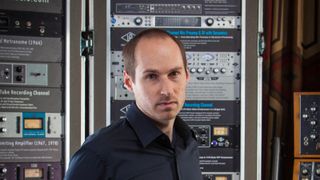Universal Audio has been making music production tools for over 50 years.After being involved in the creation of some now-classic hardware, UA successfully adapted to the digital revolution by throwing its weight into emulating it. The UAD 'powered-plugins' platform models some of the most revered studio gear, and does so using proprietary DSP chips, taking the load off your own CPU.
"In bringing its tools from the high-price studio into desktop systems everywhere, Universal Audio may be more relevant to coal-face music makers than ever before, and it was with that in mind that we put a few questions to UA's Director of Product Management, Lev Perrey…"
What's your background in music and in programming? How long have you been with UA?
"I have eight years of experience in product development and I also produce music at home. I don't do programming specifically, but I work with engineering to make sure our hardware and software do great things for recording engineers, producers, and musicians."
You've been releasing plenty of new, re-emulated versions of a lot of your UAD-2 plugins, such as the LA-2A and Fairchild. What's changed to prompt these new versions, and why do users who have the originals have to effectively buy them again?
"The originals are still great plugins, and still sound fantastic. However, over the last ten to 15 years since they've been released, we've learned new modelling techniques and have really broken ground on delivering new levels of depth and complexity of analogue emulations of the Fairchild, LA-2A, Neve 1073, and so on."

"We've included nonlinearities and subtleties that weren't possible when the legacy versions of these plugins were released"
"While they're emulations of plugins we've done before, they really should be considered new plugins in their own right. We've added Unison mic preamp modelling to these new emulations and have included nonlinearities and subtleties that weren't possible when the legacy versions of these plugins were released.
"Anyone who buys a new re-visited plugin collection gets both the new one and the light-DSP legacy version, and previous owners of the legacy plugins get a substantial discount. For example, the Fairchild Tube Limiter Collection is $299, but $149 for owners of the legacy Fairchild PlugIn."
While there's a lot of power in your newest plugins, it can be a struggle for some users to get multiple instances running due to high DSP usage. Do you have any suggested workflow tips for dealing with this?
"Our newer plugins take up a lot of DSP because they are incredibly complex. For those looking for the most authentic sound, we wanted to deliver something that was uncompromised. For those who need more instances, we also make DSP-light versions of many of our plugins.
"All DAWs also have ways to render or freeze audio with UAD plugins to save resources"
"If you have an Apollo Audio Interface, you can track with UAD plugins in real time. Recording the audio with plugins on the way in and committing them to disc will give you more room for plugins in the mixing and mastering phase. All DAWs also have ways to render or freeze audio with UAD plugins to save resources as well."
Which has been your best-selling Apollo device so far? What have been the biggest user requests - both in terms of software and hardware - and how will you address them?
"The Apollo Twin is definitely the most popular, and our original Apollo is still a strong seller as well. Since our original Apollo was released, the biggest user requests have been for the ability to have all of our Apollos work together in one system, so you can scale I/O and DSP as you grow your studio. There were also requests for improvement for our Console Application- the software component of Apollo that allows you to do real-time processing.
"We also enabled Thunderbolt Apollos to work together seamlessly on Mac via Console 2.0"
"With our recently released Apollo Expanded software, we announced Console 2.0, which addresses many user requests, including the ability to create channel strip presets, more intuitive drag and drop features, and more powerful routing and monitoring capabilities. We also enabled Thunderbolt Apollos to work together seamlessly on Mac via Console 2.0. It's made the whole Apollo ecosystem come alive by being able to 'mix and match' any Apollo model, and we're getting great feedback from customers.
"On the hardware side, we've just released a whole new line of Apollos that also address many of the hardware feature requests we've heard over the years, including next-gen conversion, headphone amp and monitoring improvements, bypassable preamp and monitoring circuitry, Unison Hi-Z inputs, and more."
You work closely with manufacturers whose gear you're modelling. Have you had any unusual requests or issues come up from the companies you've worked with?
"Every single piece of gear we model is unique, challenging and different, which is why we work closely with manufacturers to obtain their golden units and engineering expertise to arrive at a faithful replica of their hardware in software form.
"We also work to get the official stamp of approval and branding wherever possible. Some things we've modelled have taken years because we've had to go back to the drawing board and pioneer new technologies to effectively model these complex devices. This is especially true with our latest tube and tape emulations, where we've had to do some of our most advanced modelling to date."


